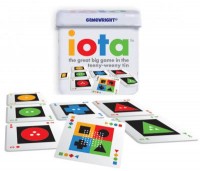
Small container, good times.
Many years ago Michelle and I played a card game at a friend?s house that required quick visual recognition to spot sets of 3 cards that were either all the same or all different in each of 4 characteristics. The card game was Set and I loved it while Michelle didn?t care for it.
It was a few years later I actually bought a copy and added it to our bin of card games. Knowing Michelle?s distaste for the game, I only pull it out occasionally ? including taking it to summer camp with the scouts.
I mention Set because when I got a copy of IOTA from Gamewright Games it reminded a lot of Set. It has a lot of similarities because players are looking at characteristics on the cards and trying to match them up with other cards that are similar or different.
With that in mind, I wasn?t sure what Michelle might think of IOTA. But when we pulled it out and played it, Michelle liked it. Sweet!
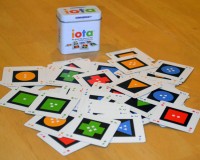
Colorful cards for light fun.
The biggest reason why she likes IOTA and doesn?t care for Set is the time pressure. In Set players are racing to be the first to spot sets and then claim the cards. That pressure of quick visual spotting drives her nuts.
But with IOTA players are in construction mode and can take their time. Instead of racing to find sets and taking the cards, each player has a hand of 4 cards and they?re looking for places to play them to the table next to appropriate cards to score points. Players also take turns so it?s not a mad dash to find the matches.
The time pressure is off and everyone scores points.
The challenge in IOTA is using your cards to score the most points. A challenge she likes.
How to play IOTA
As already mentioned, the objective in IOTA is to score the most points. Players do this by playing cards to an ever expanding grid on the table.
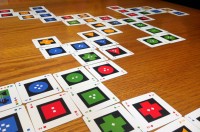
The growing IOTA grid.
Each card has 3 characteristics: Shape, Number, and Color. And there are 4 types of each characteristic.- SHAPE: Square, Triangle, Circle, and Plus
- NUMBER: 1, 2, 3, 4
- COLOR; Red, Blue, Green, Orange
When playing cards to the grid, players can add 1, 2, 3, or 4 cards from their hand to the grid as long as they meet certain criteria:
- Cards must be played next to a card already in the grid
- Cards must be played in the same line
- Each individual characteristic must either be all the same or all different on each card in the line
- Maximum line length is 4 cards
There are also 2 Wild cards in the deck that can be used to represent any combo the player would like it to be in order to fit in that position. If they need it to be a ?1 Blue Square?, then that?s what it is. And if another player later has a ?1 Blue Square? they can replace that Wild card with the real card and then use the Wild card themselves.
After playing cards to the grid, players score points based on the cards in the lines they formed. Simply add up the value of each card in each line formed or added to. If a card played is in two lines, it?s scored twice (adding up the values of one line then adding up values on the second line). And if players add the 4th card in a line that?s called a ?Lot? and their points that turn are doubled. (We?re always looking for those chances.)
Or players can Pass and switch out cards in their hand from one of the draw pile.
Once the draw pile is depleted and a player plays their last card to the grid, the game ends and scores are totaled.
Can the whole family enjoy IOTA?
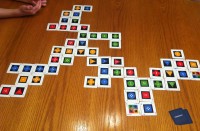
Fills the table.
IOTA can be a little tricky for younger players. It?s pretty easy for young kids to match colors, shapes or numbers. But the tricky part is being able to watch for differences as well. For example, they may see 3 red cards in a line and want to add another red card to that line. However if that line of 3 red cards includes a circle, triangle, and cross, then the card they play must be a red square. Then they must also look at the number on each card. If each card has a number 3, then they must play a red square that has a ?3? on it.
So there?s a lot to be looking out for.
In addition, scoring matters so players are also trying to calculate which cards they can play that will gain the most points. It can get tricky. But that?s also why mom likes IOTA over Set ? because she can take time to look through the possible options for play, then move in for a good score.
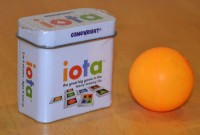
Tiny tin and cards are great.
Caleb has also taken to IOTA very well. The first time we played, he wasn?t there when we started but watched for a minute and then teamed up with grandma ? helping her find a number of great spots to play for big points. And team Caleb / Grandma ended up winning.Itty-bitty cards
Another thing we like are the itty-bitty cards. The deck of 64 cards comes in a tiny tin that?s super easy to take anywhere. We took a picture of the card game tin next to a table tennis ball (ping pong ball) so you could get a feel for the size. But with how sprawling the grid may get on the table, it?s a good thing the cards are small.
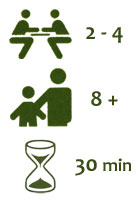 How does IOTA score on the ?Let?s Play Again? game meter?
How does IOTA score on the ?Let?s Play Again? game meter?
IOTA gets a good score on the ?let?s play again? game meter because of how simple it is to play. And it?s also super easy to grab off of the game shelf because of it?s size. If we?re heading up to grandma?s for dinner, it?s an easy call to bring IOTA along.
Thanks Gamewright for another solid family card game!
?
Source: http://www.theboardgamefamily.com/2013/02/iota-card-game-review/
Hurricane Sandy Nyc Saanvi Venna vikings Colin Powell Tyrann Mathieu noaa Jessica Ridgeway
No comments:
Post a Comment